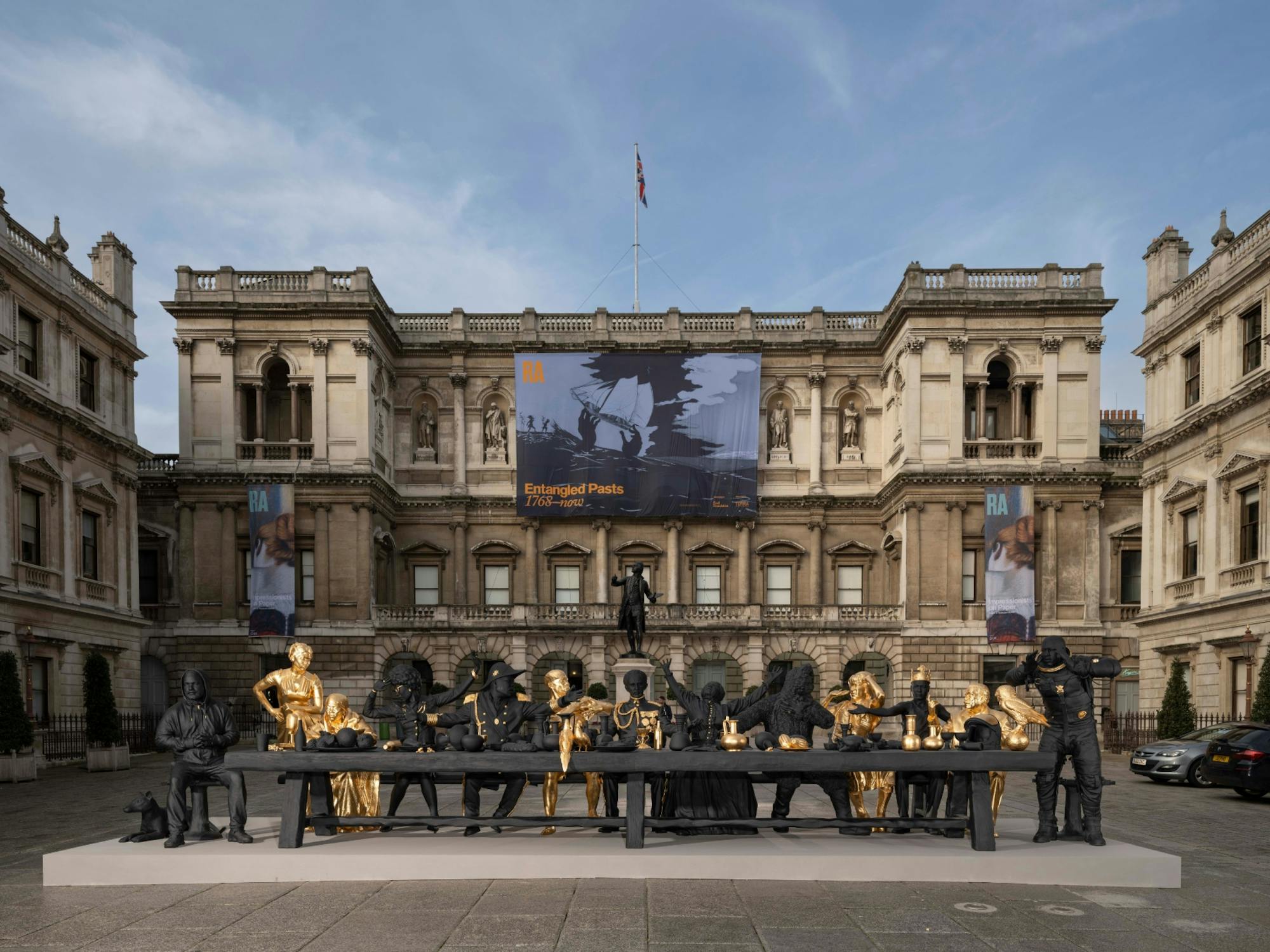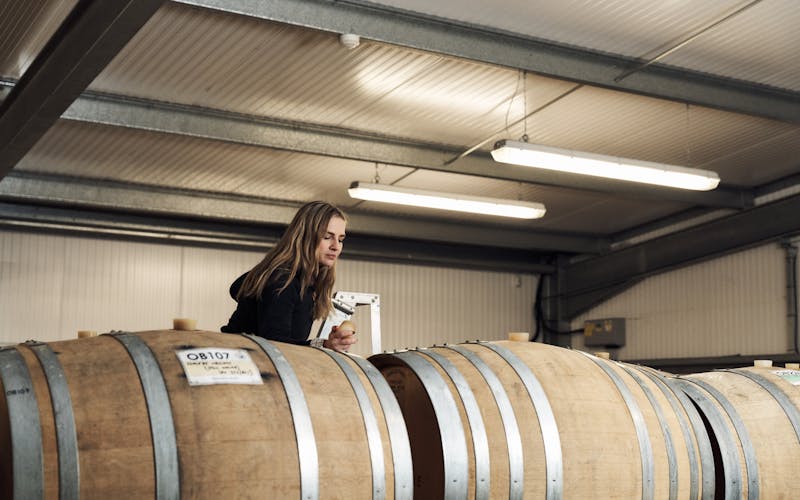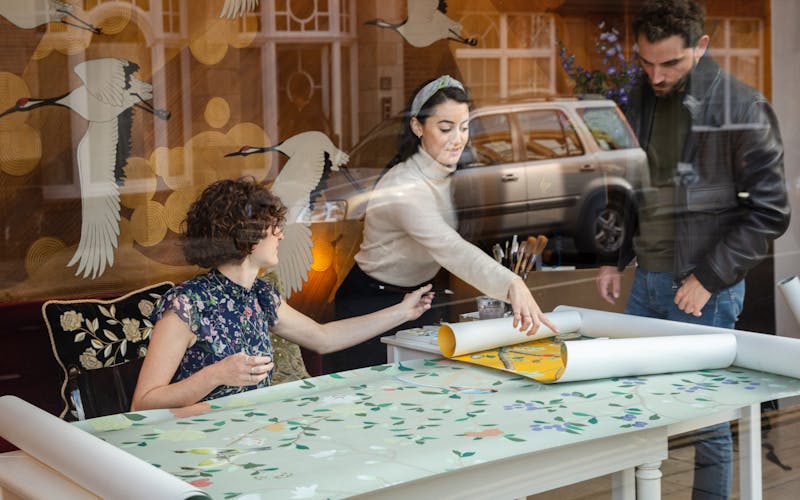
A scantily lit antechamber greets visitors as they take their first step inside Entangled Pasts, the Royal Academy’s latest exhibition. At its centre sits Bust of a Man (1758); bright spotlights giving relief to a high forehead and absent eyes. The black stone from which the work is carved alludes to the Blackness of Francis Harwood’s subject, though the absence of a name conceals the subject’s identity. This striking piece captures a curatorial principal outlined by one of the exhibition’s curator, Dr Dorothy Prince FBA: to make visible the invisible gaps in the artistic narratives of empire, enslavement, and colonisation. Above Bust of a Man hang four mirrors, angled inwards. These mirrors do not merely reflect the artwork below – they reflect the observer, too. “You are looking at yourself in relation to the art,” Prince explains. This relationship between the observer and the art is crucial, developing engagement for the visitor beyond contemplation into conversation, constructive dialogue and debate.
Beyond this first room is a gallery dedicated to printmaking and poetry. “In the eighteenth century, print played a far greater role in forming our impressions and understandings of the world,” curator Sarah Lea explains. She gestures towards a print entitled Voyage of the Sable Venus from Angola to the West Indies (1794), a reproduction by William Grainger of a lost work by Royal Academician, Thomas Stothard. The piece was commissioned by plantation owner and politician Bryan Edwards for the second edition of The History, Civil and Commercial, of the British Colonies in the West Indies, which sought to demonstrate to readers that enslavement was a benevolent practice. Voyage of the Sable Venus, which was the book’s front plate, glorifies the transportation of slaves through The Middle Passage, a step of the Atlantic slave trade in which enslaved Africans were transported to the Americas. “Art can normalise these ideological representations,” Lea continues. “Institutions such as the Royal Academy have participated in creating a history that does not acknowledge Black subjectivity.”
Next to Voyage of the Sable Venus hangs Black Venus (1957), a response of sorts from twentieth century African-American activist and visual artist Margaret Burroughs. The lino print preserves the composition of Stothard’s work yet it abstracts its figures, emphasising not the enslavement of Black women, but rather their resilience. “Slave masters selected the most beautiful of the virgin Black slave women for their own personal use,” Burroughs comments in her notes that accompany the work, “and yet these women survived to become mothers of a nation.”
This juxtaposition is a demonstration of why Lea and the RA curatorial team chose not to display Entangled Pasts chronologically – pieces are displayed in dialogue with one another to address the tensions of subjectivity and agency. Across centuries, cultures and canons, the team traces connections between works to underscore the convergence and divergence of historical narratives.
Lea draws particular attention to Lessons of the Hour (2019), a work by contemporary filmmaker and Installation artist Isaac Julien centred on nineteenth century African-American abolitionist and freed slave Frederick Douglass. The narrative is informed by some of Douglass’ most important speeches from his campaigning in England, Scotland and Ireland between 1845 and 1847, a period during which slavery was still legal in the US. The women characters on the screen represent ideas of gender equality; the twenty-nine-minute film consistently foregrounds both Black and female subjectivity.
In the same room stands John Bell’s The American Slave (1853). Initially exhibited at the Royal Academy in 1953 as a powerful statement against the practice of slavery, Lea explains that “[it] does not so much communicate the experience of the enchained woman figure as commodify and fetishise the woman’s figure.” Bell’s representation of an idealised Black woman replicates the dynamics of viewing and possession to which enslaved people were subjected. Frederick Douglass and John Bell both advocated for abolitionism during the same period of history, yet the diverging results of their work exemplify that, “you have to distinguish between the purpose of a piece of art and how it actually works,” Lea explains. “These pieces, together, draw out the tensions around questions of freedom,” she continues, acknowledging the complexity of freedom, and the radically different journeys of freedom between races that continue to obstruct racial equality today.
The idea for Entangled Pasts emerged in response to public debates prompted by the Black Lives Matter protests and the toppling of the statue of Edward Colston in Bristol in 2020. The prominence of this exhibition demonstrates the evolution of the Royal Academy's attitude since its establishment in 1768, when founding President, Joshua Reynolds referred to the RA as an ‘ornament’ to Britain’s empire. While holding sympathies towards the British empire, Reynolds displayed abolitionist sentiment, stating his opposition to the slave-trade at a dinner with friends around 1787. “[In centuries past] an individual could support the abolition of slavery, while also supporting racial hierarchies dependent upon Black oppression,” Lea points out. Societies – and individuals, too – held conflicting opinions, tightly binding discordant narratives in an entwined historical tapestry.
Entangled Pasts explores the evolving role of art in shaping these narratives – a single strand of a broader strategy which includes decolonial research, talks, events, and online content. These strands comprise a forum for acknowledgement, reflection and debate, which shall support the RA in its next step – one towards necessary change.
'Entangled Pasts, 1768–now' runs until Sunday 28th April 2024 at the Royal Academy of Arts, Burlington House, Piccadilly, London W1J 0BD. royalacademy.org.uk





